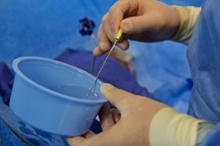
J. David Prologo, MD, delivered new findings from an Emory Interventional Radiology and Image Guided Medicine study at the Society of Interventional Radiology’s 2016 Annual Scientific Meeting. The study examines the use of cryoablation, or extreme cold, to reduce phantom limb pain (PLP) – a condition that causes individuals to perceive chronic pain in amputated limbs. Emory’s study shows interventional radiologists who applied cold blasts to patients suffering from PLP significantly reduced their level of pain.
The clinical trial, entitled “Percutaneous Image Guided Cryoablation for the Treatment of Refractory Phantom Limb Pain” examines the safety and effectiveness of using cryoablation to treat patients with PLP. According to the Centers for Disease Control and Prevention, nearly 185,000 amputations occur each year in the United States. Many people who’ve undergone amputations are military veterans wounded in combat and people who have had surgical amputations performed for various medical
conditions.
“More veterans than ever are returning from war with amputations, because of improved body armor and extraction techniques,” says Prologo, director of Interventional Radiology at Emory Johns Creek Hospital, and assistant professor in the Department of Radiology and Imaging Sciences in Emory’s School of Medicine. “At the same time, veterans who fought in the Vietnam War still suffer from phantom limb pain. Until now, they’ve had few medical interventions available to them with the potential to reduce significant pain,” says Prologo.
Emory interventional radiologists have enrolled the maximum capacity of 25 participants in this prospective, single-arm study. Investigators asked patients to rate their pain using the visual analogue scale (VAS), ranging from 0 mm (no pain) to 100 mm (worse pain possible) before, seven days after and 45 days after the procedure. Before cryoablation, patients reported an average pain score of 6.4 points, and by day 45 the average
scores fell to 2.4 points.
Prologo says during the hour-long outpatient procedure, interventional radiologists use image guidance to access hard-to-target areas and shut down problematic nerves.
“We insert a cryoablation probe into the nerves causing pain and drop the temperature to negative 40 degrees centigrade for 25 minutes,” says Prologo.
Emory researchers will collect data on this PLP study supported by Galil Medical, until February 2017.
